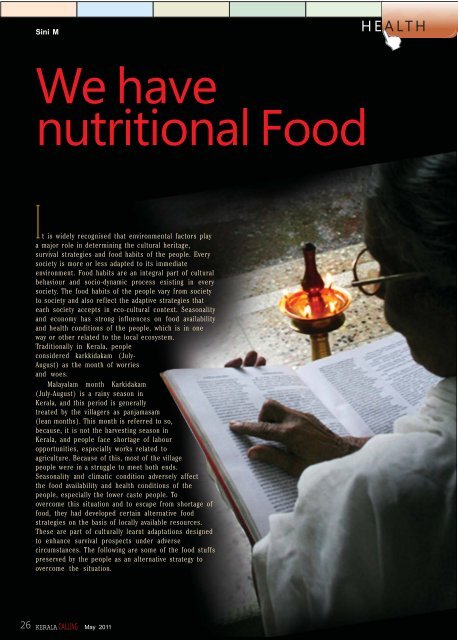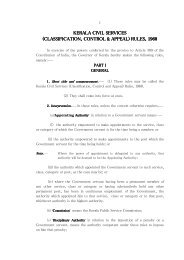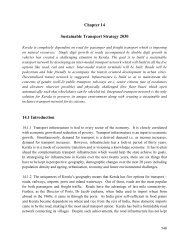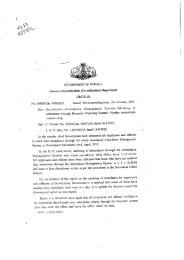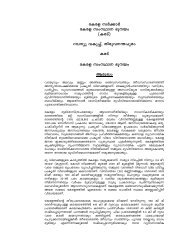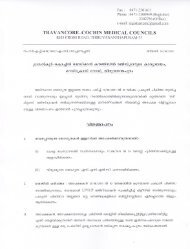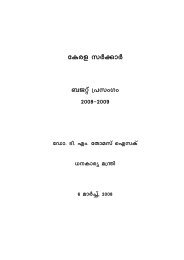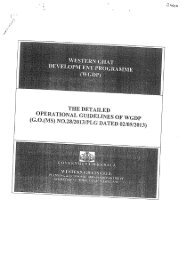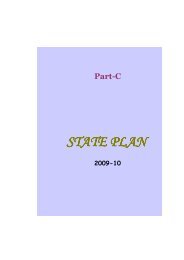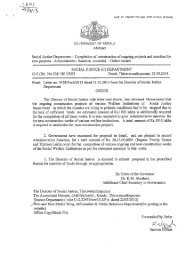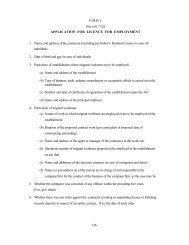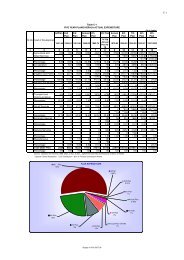You also want an ePaper? Increase the reach of your titles
YUMPU automatically turns print PDFs into web optimized ePapers that Google loves.
Sini M<br />
HEALTH<br />
We have<br />
nutritional Food<br />
It is widely recognised that environmental factors play<br />
a major role in determining the cultural heritage,<br />
survival strategies and food habits of the people. Every<br />
society is more or less adapted to its immediate<br />
environment. Food habits are an integral part of cultural<br />
behaviour and socio-dynamic process existing in every<br />
society. The food habits of the people vary from society<br />
to society and also reflect the adaptive strategies that<br />
each society accepts in eco-cultural context. Seasonality<br />
and economy has strong influences on food availability<br />
and health conditions of the people, which is in one<br />
way or other related to the local ecosystem.<br />
Traditionally in Kerala, people<br />
considered karkkidakam (July-<br />
August) as the month of worries<br />
and woes.<br />
Malayalam month Karkidakam<br />
(July-August) is a rainy season in<br />
Kerala, and this period is generally<br />
treated by the villagers as panjamasam<br />
(lean months). This month is referred to so,<br />
because, it is not the harvesting season in<br />
Kerala, and people face shortage of labour<br />
opportunities, especially works related to<br />
agriculture. Because of this, most of the village<br />
people were in a struggle to meet both ends.<br />
Seasonality and climatic condition adversely affect<br />
the food availability and health conditions of the<br />
people, especially the lower caste people. To<br />
overcome this situation and to escape from shortage of<br />
food, they had developed certain alternative food<br />
strategies on the basis of locally available resources.<br />
These are part of culturally learnt adaptations designed<br />
to enhance survival prospects under adverse<br />
circumstances. The following are some of the food stuffs<br />
preserved by the people as an alternative strategy to<br />
overcome the situation.<br />
26 KERALA CALLING May <strong>2011</strong>
Pukkan<br />
It is a kind of food item prepared and<br />
consumed by the lower caste people of<br />
North Malabar, especially economically<br />
backward families in the past. Earlier, the<br />
rice grains (Oryza sativa) were freed from<br />
bran by hand pounding. During<br />
Karkkidakam, they daily collected water<br />
left after cleaning the rice from the nearby<br />
houses in an earthen pot. The peculiarity<br />
of this rice was that it has not been<br />
cleaned in such away and to be removed<br />
off its coatings. So the grains obtained in<br />
this manner were brown coloured .The<br />
brown covering is rich in nutritious<br />
proteins and minerals and the collected<br />
water contains tavidu (Bran). The tavidu<br />
(bran) is a powdery mass consisting of<br />
aleurone layer (Protein, 5-10 per cent)<br />
and the outer layers of the Kernel<br />
(Carbohydrate, 40-50 per cent). Every day<br />
they collected the water after washing<br />
the rice into a big earthen pot and<br />
allowing it to condense and filtered off<br />
water above the condensed portion. This<br />
part of the water contains the essence of<br />
tavidu (Bran). This process continued up<br />
to one week. In this concentrated water<br />
they also add tiny particles of rice, locally<br />
known as nurikkilari, which they<br />
collected daily while husking and<br />
cooking. After one week they boil this<br />
collected essence till it concentrates and<br />
was consumed as a substitute of Kanji.<br />
The protein rich bran of rice was also<br />
consumed by the people. The main<br />
content of Pukkan is tavidu (Bran) and<br />
it richly contains Vitamin B (Vitamin B1<br />
to B12). It also contains starch, protein<br />
and fat. The Tavidu (Bran) coated rice,<br />
locally known as Karambilari.<br />
One ounce bran coated rice<br />
contains: Starch-2.3gm, Fat-<br />
0.2gm, Protein- 2gm and<br />
the energy received is 98<br />
colorie / one ounce.<br />
Ayurveda says that<br />
tavidu has a<br />
significant medicinal<br />
value in reducing<br />
vatha, pitha, and kafa<br />
dosha.<br />
Mangayandi<br />
kanji (Gruel<br />
prepared with<br />
Mango seeds)<br />
Mango (Mangifera<br />
indica) was another important<br />
item of food. In Kerala, mango trees<br />
were in plenty a few decades ago.<br />
During karkkidakam they prepared kanji<br />
with the seeds of Mango, locally known<br />
as kuratta as an alternative food item.<br />
They collected the seeds during the<br />
season when mango was available in<br />
plenty and stored it. During the period of<br />
food shortage , they take the seeds after<br />
breaking the seed coat and are kept in<br />
sacks and put in the water (sometimes<br />
in nearby streams or ponds ) for 3-5 days.<br />
This is to remove the bitter taste of the<br />
seeds while in use. Sometimes they put<br />
the seeds inside the earthen pot<br />
containing water. Everyday they filtered<br />
off the water and replenish freshwater to<br />
remove the bitter taste. Then they mix<br />
the seeds with nicheri or nurikkilari and<br />
prepare mangayandikanji by boiling it.<br />
This preparation was also an alternative<br />
to Kanji.<br />
Mangayandi kanji also played a vital<br />
role in protecting the health of<br />
economically backward among the<br />
lower caste people of rural areas few<br />
decades back. Mangayandi (seeds of<br />
Mango) contains Vitamin A and C in rich<br />
quantity. It also contains Phospherous,<br />
fat, iron, calcium and galicacid.<br />
Mangayandi (seeds of Mango) is very<br />
important and used as an Ayurvedic<br />
medicine for Kapha and worm infection<br />
in children and it is good for treating<br />
stomach ailments.<br />
Pulinkuru kanji (Gruel<br />
prepared with Tamarind seeds)<br />
It was another substitute for Kanji.<br />
The seeds of Tamarind (Tamarindus<br />
indica) were collected during available<br />
seasons and were stored. During the<br />
shortage of food, it was fried and the fried<br />
seeds were put into an ural (mortar) and<br />
grinded to remove the seed coat. The<br />
seeds then boiled to remove the bitter<br />
taste. After that the seeds are dried in<br />
sunshine. This dried seeds again grinded<br />
to make powder. This powder is then<br />
mixed with nicheri and boils. This is an<br />
important preparation during<br />
karkkidakam. The leaves of Tamarind<br />
were also used to make curries. Tamarind<br />
accelerates digestion.<br />
Manpidikkal<br />
Seeds of Jackfruit (Artocarpus<br />
heterophyllus) were another important<br />
item widely used during panjamasam<br />
(lean months). Few years ago the<br />
availability of jackfruit was in plenty.<br />
During the season of jackfruit people<br />
collected it and the seeds were dried in<br />
sunshine. They stored the extra seeds by<br />
mixing it with mud or soil and kept in<br />
the corner of the kitchen like a hump.<br />
May <strong>2011</strong><br />
27<br />
KERALA CALLING
This is known as Manpidikkal. The<br />
collected seeds were thus kept for one<br />
year. During panjamasam they take small<br />
quantities of it from the hump. Sometimes<br />
they prepare it as curry or put the seeds<br />
into fire, roast it and consumed. 100 gm<br />
seeds of Jackfruit contain: Protein- 6.6gm,<br />
Fat- 4gm, Iron-1.5mg, Calcium- 50mg,<br />
Starch- 25.8gm and little Carbohydrate.<br />
Jackfruit is a rich source of protein. The<br />
seeds of Jackfruit contain an anticancerous<br />
substance called lectin<br />
(starch – protein complex) in<br />
abundance. In addition to these food<br />
items, they also consumed varieties of<br />
leaves. The main leaf items consumed<br />
by the lower caste people are,<br />
Amaranthus, Colocasia esculenta and<br />
Cassia tora.<br />
Amaranthus – Its leaves and tender<br />
twigs were used as vegetable and it<br />
contains iron richly 18.18mg/100g<br />
Colocasia esculenta- The leaves<br />
contain: Starch -25 per cent, Water -68 per<br />
cent, Sugar -3 per cent, rotein -2 per cent<br />
and little Fat. In addition, green leaves<br />
contain large amount of iron, large<br />
amounts of B carotene, folic acid and<br />
protein as well as extensive amount of<br />
pyridoxine, riboflavin and copper.<br />
28 KERALA CALLING May <strong>2011</strong>
The traditional food items of the<br />
people of Kerala, especially of lower caste,<br />
were generally the resources available<br />
from their immediate environment. In the<br />
past, rice, tubers, fruits, leaves etc. had<br />
taken a dominant place in their diet. The<br />
excess seeds of these resources they<br />
preserved and the alternative food items<br />
they prepared were used during the<br />
period of food shortage. This natural food<br />
gave them adequate nutrients essential<br />
for their health.<br />
It is seen that human beings these<br />
days changing their traditional way of<br />
life and food habits to modern style. But<br />
its nutritional aspects are still a matter of<br />
controversy. Most of the market based<br />
food items lack nutrients essential for our<br />
health. Today fast foods and other<br />
readymade food items dominate in the<br />
food cultures of Malayalis. Today food<br />
culture of the Malayali is influenced<br />
largely by the Media which are part of<br />
the globalised scenario. It is observed that<br />
market economy and globalisation<br />
forces enriched the food world of the<br />
people today.•<br />
The writer is Lecturer, Department of<br />
Anthropology, Kannur University, Thalassery<br />
Campus.<br />
May <strong>2011</strong><br />
29<br />
KERALA CALLING


